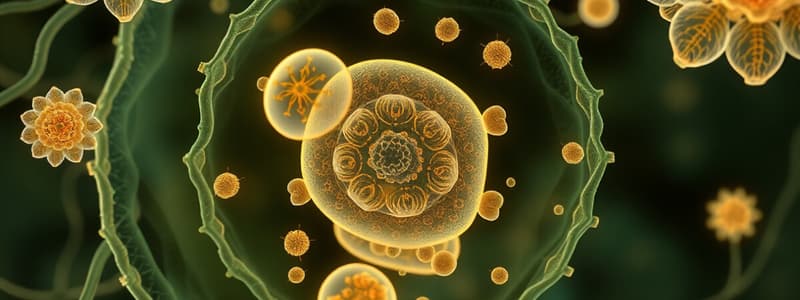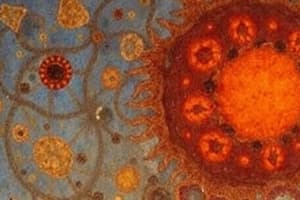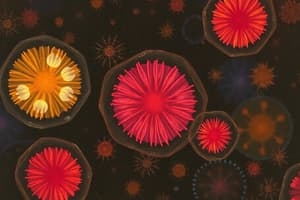Podcast
Questions and Answers
Which of the following structures is NOT directly involved in protein production or processing?
Which of the following structures is NOT directly involved in protein production or processing?
- Nucleolus
- Peroxisome (correct)
- Golgi Apparatus
- Rough Endoplasmic Reticulum
A cell is placed in a solution, and it begins to swell. Which of the these terms best describes the solution relative to the cell's interior?
A cell is placed in a solution, and it begins to swell. Which of the these terms best describes the solution relative to the cell's interior?
- Hypotonic (correct)
- Isotonic
- Hypertonic
- Homeostatic
Which of the following transport mechanisms requires the cell to expend energy (ATP)?
Which of the following transport mechanisms requires the cell to expend energy (ATP)?
- Simple Diffusion
- Facilitated Diffusion
- Active Transport (correct)
- Osmosis
What is the primary role of the nuclear envelope?
What is the primary role of the nuclear envelope?
Which of the following best explains the significance of the inner folds (cristae) of the mitochondria?
Which of the following best explains the significance of the inner folds (cristae) of the mitochondria?
A scientist observes a cell using a microscope and notices numerous vesicles fusing with the plasma membrane, releasing their contents outside the cell. Which process is the scientist most likely observing?
A scientist observes a cell using a microscope and notices numerous vesicles fusing with the plasma membrane, releasing their contents outside the cell. Which process is the scientist most likely observing?
In plant cells, a large central vacuole is crucial for maintaining turgor pressure. What is the primary benefit of turgor pressure to the plant?
In plant cells, a large central vacuole is crucial for maintaining turgor pressure. What is the primary benefit of turgor pressure to the plant?
Which of the following characteristics distinguishes eukaryotes from prokaryotes?
Which of the following characteristics distinguishes eukaryotes from prokaryotes?
Lysosomes are responsible for degrading cellular waste and debris. What is the most likely consequence if lysosomes were NOT functioning correctly in a cell?
Lysosomes are responsible for degrading cellular waste and debris. What is the most likely consequence if lysosomes were NOT functioning correctly in a cell?
Microfilaments, microtubules, and intermediate filaments are all components of the cytoskeleton. What is the primary function of the cytoskeleton?
Microfilaments, microtubules, and intermediate filaments are all components of the cytoskeleton. What is the primary function of the cytoskeleton?
Flashcards
Nucleus Function
Nucleus Function
Stores genetic material (DNA) and controls cell activities.
Plasma Membrane Function
Plasma Membrane Function
Regulates the entry and exit of substances in the cell.
Cytoplasm Function
Cytoplasm Function
Jelly-like fluid that holds organelles and facilitates biochemical reactions.
Mitochondria Function
Mitochondria Function
Signup and view all the flashcards
Chloroplasts Function
Chloroplasts Function
Signup and view all the flashcards
Golgi Apparatus Function
Golgi Apparatus Function
Signup and view all the flashcards
Lysosomes Function
Lysosomes Function
Signup and view all the flashcards
Peroxisomes Function
Peroxisomes Function
Signup and view all the flashcards
Vacuoles Function
Vacuoles Function
Signup and view all the flashcards
Ribosomes Function
Ribosomes Function
Signup and view all the flashcards
Study Notes
- The cell is the basic unit of life.
Nucleus
- Stores genetic material (DNA).
- Controls cell activities.
- Nuclear envelope: A double membrane that protects DNA
- Nucleolus: Produces ribosomes.
- Chromatin: DNA and protein complex.
Plasma Membrane
- Regulates entry and exit of substances.
- Structure: Phospholipid bilayer with embedded proteins.
Cytoplasm
- Jelly-like fluid that holds organelles.
- Facilitates biochemical reactions.
Organelles in Eukaryotic Cells
Energy Related Organelles
- Mitochondria: Powerhouse of the cell; produces ATP through cellular respiration.
- Double membrane with inner folds (cristae).
- Chloroplasts (in plant cells): Site of photosynthesis, contains chlorophyll, thylakoids, and a double membrane.
Endomembrane System
- Endoplasmic Reticulum (ER):
- Rough ER: Has ribosomes, involved in protein synthesis.
- Smooth ER: No ribosomes; synthesizes lipids and detoxifies chemicals.
- Golgi Apparatus: Modifies, sorts, and packages proteins and lipids for transport.
- Lysosomes (mainly in animal cells): Contains digestive enzymes to break down waste and cellular debris.
- Peroxisomes: Breaks down fatty acids and neutralizes toxins.
Cytoskeletal Components
- Microtubules: Provide structure, help in cell division (spindle fibers).
- Microfilaments: Assist in movement and shape maintenance.
- Intermediate filaments: Provide mechanical strength.
Vacuoles
- Storage of nutrients, water, and waste.
- In plants: Large central vacuole helps maintain turgor pressure.
- In animals: Smaller and involved in transport.
Ribosomes
- Protein synthesis.
- Made of RNA and proteins.
- Found in the cytoplasm or attached to the rough ER.
Centrioles (in animal cells)
- Helps in cell division by forming spindle fibers.
- Viruses are NOT cells
- Cell theory: Every living organism is composed of one or more cells, from preexisting cells
- Prokaryotes: Bacteria, simple and single celled.
- Eukaryotes: Plants, animals, fungi, and protists, larger and more complex, double membraned enclosed nucleus.
- Both prokaryotes and eukaryotes: Dna, Cytoplasm, Ribsomes, Plasma Membrane
Diffusion
- The process by which molecules or particles move from an area of higher concentration to an area of lower concentration.
Passive transport
- NO ENERGY REQUIRED
- Simple diffusion: Movement of molecules directly across a membrane or through a medium without the need for energy or assistance.
- Example: Oxygen and carbon dioxide diffusing across cell membranes.
- Movement of molecules across a membrane via specific transport proteins (carrier or channel proteins) without using energy.
- Example: Glucose transport through GLUT transporters in cells.
- A special type of diffusion involving the movement of water molecules across a selectively permeable membrane from a region of lower solute concentration to higher solute concentration.
- Example: Water moving into a dehydrated cell.
Active transport
- ENERGY REQUIRED
Types of transport
- Vesicles: Move molecules from place to place and in and out.
- Endocytosis: The process in which materials are transported INTO the cell.
- 3 types of endocytosis
- Receptor mediated endocytosis: receptor proteins embedded in the membrane recognize specific surface characteristics of substances to be incorporated into the cell. Ex: Human cells use receptor mediated endocytosis to take up cholesterol containing packages.
- Phagocytosis: cellular eating particles considerably larger than than biomolecules are ingested
- Pinocytosis: cellular drinking fluids are ingested.
- Exocytosis: The way materials are transported OUT of the cell via vesicles
- Isotonic: solute concentration equal to that of the cell it surrounds
- Hypertonic: a fluid that has a solute concentration HIGHER than that of the cell it surrounds
- Hypotonic:a fluid that has a solute concentration LOWER than that of the solute it surrounds
- Hosts: an organism that provides a home for another organism, called a parasite
- Viruses: a microscopic, infectious particle that contains genetic material and a protective protein coating
Studying That Suits You
Use AI to generate personalized quizzes and flashcards to suit your learning preferences.




